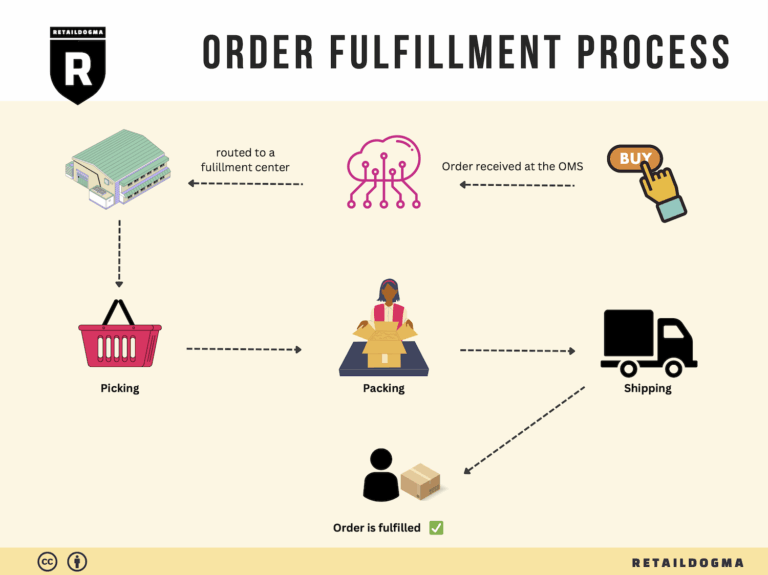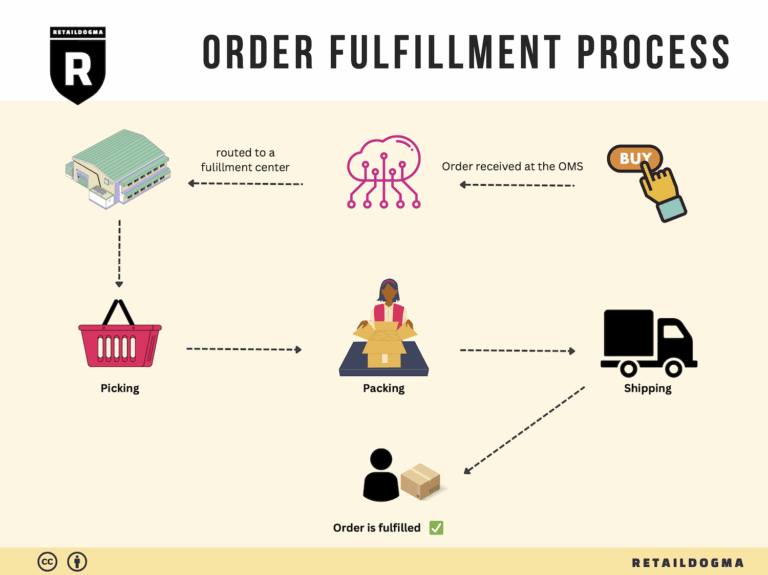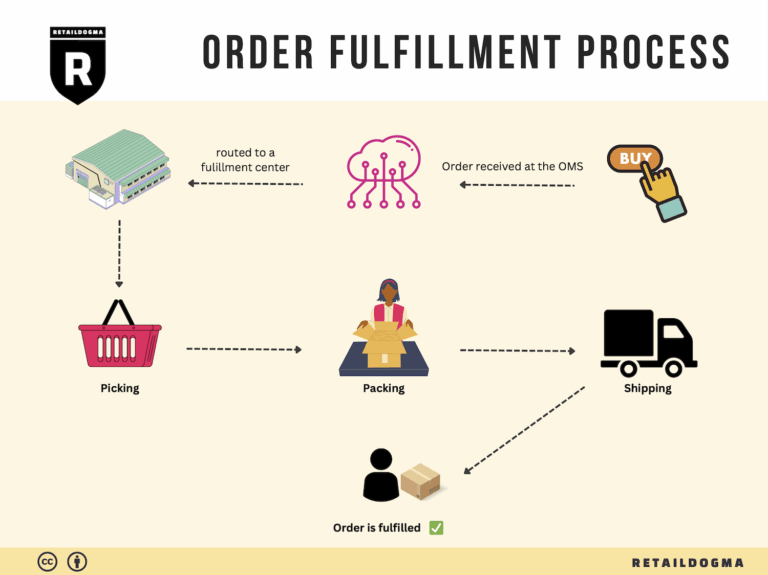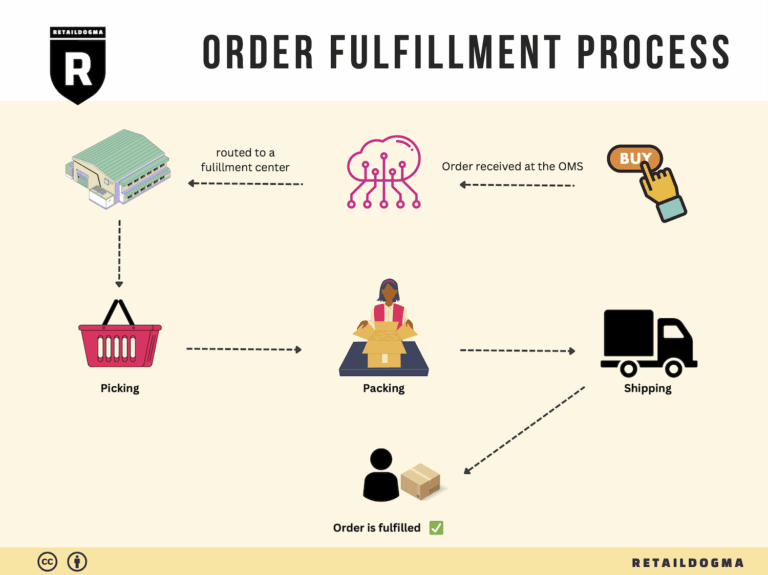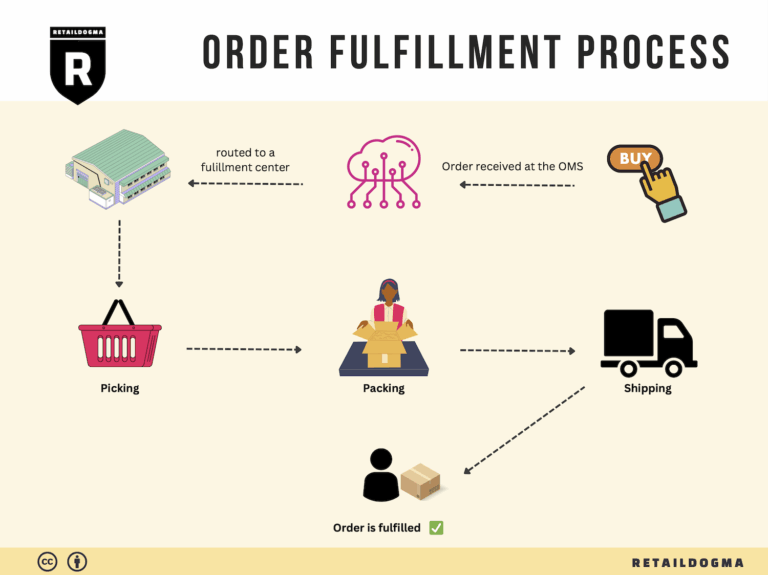What Is A Fulfillment Center? A Complete Guide (2025)
What is E-commerce Fulfillment? An Introduction for Growing Businesses
As your e-commerce business begins to gain traction, the excitement of increasing sales can quickly turn into a daunting challenge. One of the most common pain points for growing online retailers is the overwhelming task of packing and shipping orders. What starts as a manageable workload can escalate into a logistical nightmare, consuming valuable time and resources. This is where e-commerce fulfillment comes into play.
Understanding E-commerce Fulfillment
At its core, e-commerce fulfillment refers to the entire process of getting a product from your warehouse or fulfillment center to your customer’s doorstep. This includes everything from receiving and storing inventory, picking and packing orders, to shipping and handling returns. As your business scales, the complexity of these operations increases, and effective fulfillment becomes crucial for maintaining customer satisfaction and ensuring smooth operations.
What This Guide Covers
In this guide, we will explore the various models of e-commerce fulfillment that can support your growing business. You’ll learn about Third-Party Logistics (3PL) providers, Fulfillment by Amazon (FBA), and other options that allow you to focus on your core business activities while leaving the logistics to the experts.
We’ll break down the core services typically offered by fulfillment partners, including:
- Inventory Management: Keeping track of stock levels to prevent shortages or overstock situations.
- Pick and Pack Services: Efficiently selecting items and preparing them for shipment.
- Shipping Solutions: Navigating the complexities of domestic and international shipping.
- Returns Management: Handling returns smoothly to maintain customer trust.
Choosing the Right Fulfillment Partner
Selecting the right fulfillment partner is a critical decision that can impact your business’s efficiency and customer satisfaction. We will provide insights on what to look for in a logistics partner, including technology integration, pricing models, and customer service responsiveness.
Pricing Considerations
Understanding the cost structures associated with different fulfillment options is essential for budgeting and forecasting. We will outline common pricing models and factors that can influence your overall logistics costs.
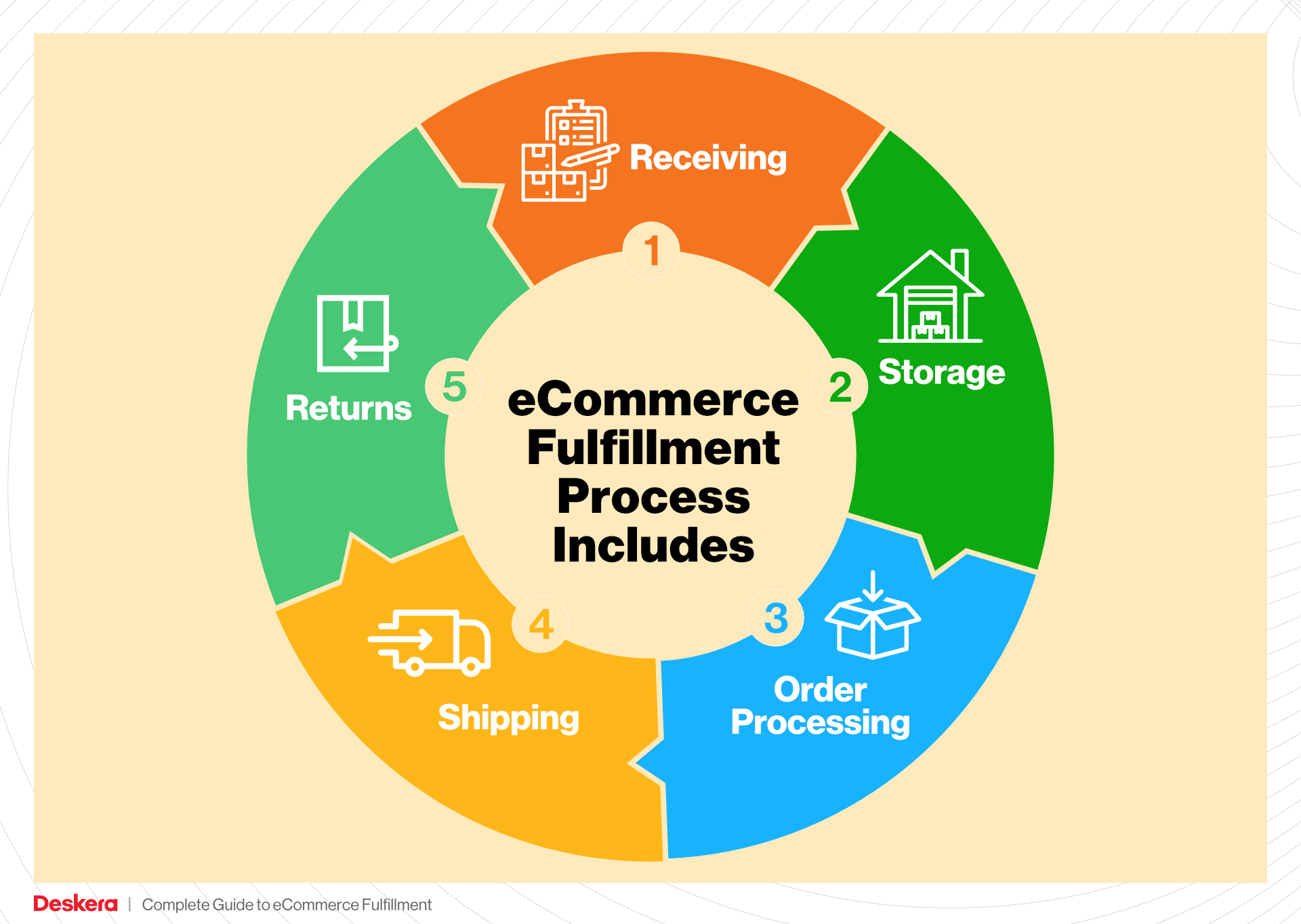
Empowering Your Business Decisions
Ultimately, this guide aims to empower you to make informed decisions about your logistics strategy. By understanding the ins and outs of e-commerce fulfillment, you’ll be better equipped to scale your operations, enhance customer experiences, and drive your business growth. Whether you are a startup looking to establish a solid foundation or an established retailer seeking efficiency, mastering fulfillment is key to your success in the competitive e-commerce landscape.
What You’ll Learn In This Guide
- What is E-commerce Fulfillment? An Introduction for Growing Businesses
- The Order Fulfillment Process: From ‘Buy’ Button to Customer’s Door
- Comparing Fulfillment Models: In-House vs. 3PL vs. Dropshipping
- A Deep Dive into Amazon FBA: Pros, Cons, and Who It’s For
- Core Services Offered by Fulfillment Centers
- How to Choose a Fulfillment Partner: A 6-Point Checklist
- Understanding Fulfillment Pricing: A Breakdown of Common Fees
- Frequently Asked Questions (FAQs) about Fulfillment
- Conclusion: Is Outsourcing Fulfillment the Right Move for Your Business?
- Important Disclaimer
The Order Fulfillment Process: From ‘Buy’ Button to Customer’s Door
1. Receiving Inventory
The first step in the order fulfillment process is receiving inventory. This involves accepting goods from suppliers and ensuring they match the purchase orders. Key tasks include inspecting items for damage, verifying quantities, and entering them into the inventory management system using unique identifiers such as Stock Keeping Units (SKUs).
Why It’s Important: Proper inventory receipt is crucial for maintaining accurate stock levels and ensuring that customers receive the correct items. Inaccuracies at this stage can lead to stockouts or excess inventory, both of which can negatively impact customer satisfaction and cash flow.
Key Term: SKU (Stock Keeping Unit) – A unique identifier that helps track inventory items and manage stock efficiently.
2. Warehouse Storage
Once the inventory is received and verified, it is stored in the warehouse. Effective storage involves organizing items in a way that maximizes space and facilitates easy access. Common methods include shelving, pallet racking, and bin systems. Each item’s location is recorded in the inventory management system, allowing for efficient retrieval later.
Why It’s Important: Efficient warehouse storage is essential for minimizing retrieval times and maximizing space utilization. A well-organized warehouse reduces the risk of errors during the picking process and enhances overall operational efficiency.
Key Term: Inventory Management System – Software that tracks inventory levels, orders, sales, and deliveries, ensuring that stock is managed effectively.
3. Order Picking
Order picking is the process of selecting the correct items from the warehouse to fulfill customer orders. This involves generating a pick list, which details the items and their locations within the warehouse. Warehouse staff or automated systems then retrieve these items, ensuring accuracy and efficiency.
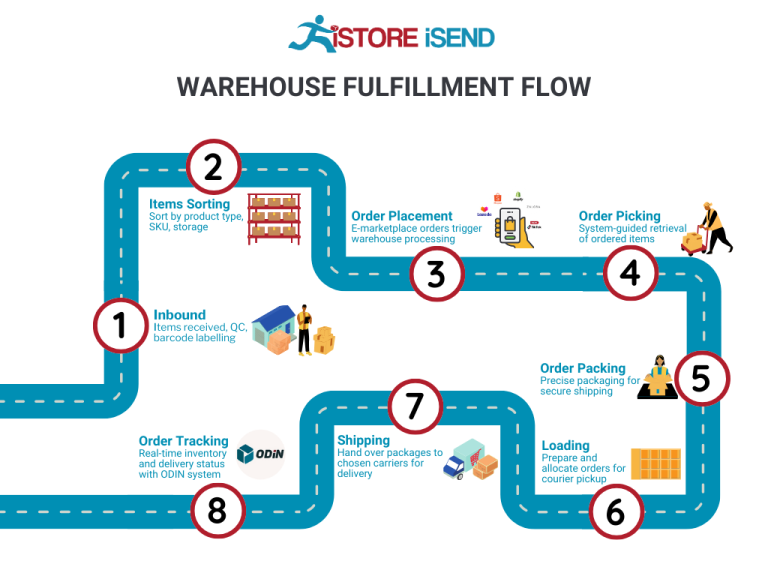
Why It’s Important: The accuracy of order picking directly impacts customer satisfaction. Errors during this stage can lead to incorrect shipments, which can cause delays, returns, and increased operational costs. Therefore, investing in technologies like barcode scanning can significantly enhance picking accuracy.
Key Term: Pick List – A document or digital tool that outlines the items to be picked for fulfilling a specific order, including their locations in the warehouse.
4. Order Packing
After the items are picked, they must be carefully packed for shipment. This step involves selecting appropriate packaging materials, ensuring items are protected during transit, and including any necessary documentation, such as invoices or return labels. Additionally, branding elements can be added to create a memorable unboxing experience for customers.
Why It’s Important: Effective packing not only protects products but also enhances the customer’s perception of your brand. Properly packed items reduce the likelihood of damage during shipping, thereby minimizing returns and associated costs.
Key Term: Packing Slip – A document that accompanies the shipment, detailing the items included in the package and serving as a receipt for the customer.
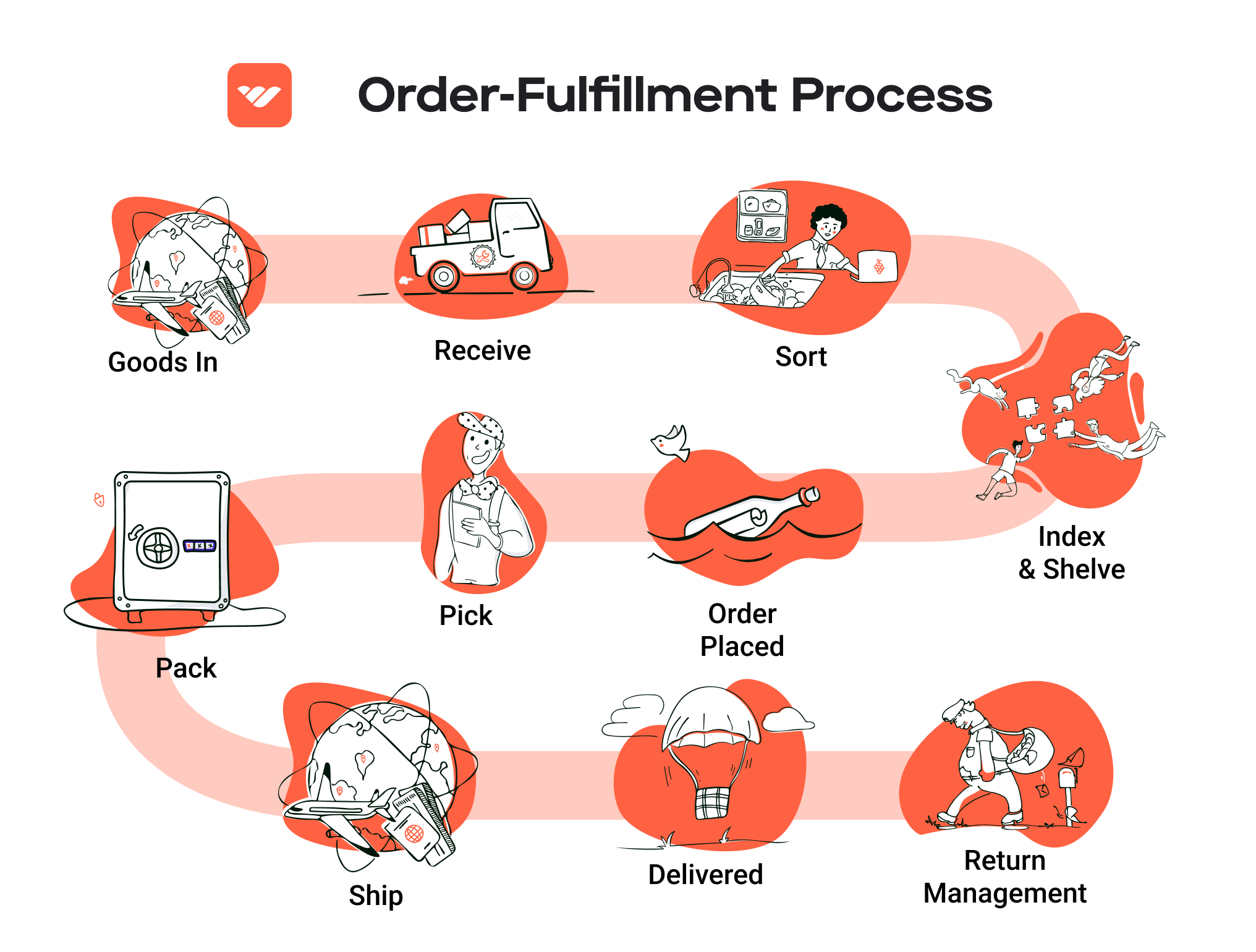
5. Shipping & Delivery
The final step in the order fulfillment process is shipping and delivery. This involves selecting a shipping carrier, generating shipping labels, and dispatching the packages. It’s crucial to choose carriers that align with your delivery promises, whether it’s expedited shipping or cost-effective options. Tracking information should be provided to customers to enhance transparency.
Why It’s Important: Timely delivery is a key factor in customer satisfaction. Efficient shipping processes can lead to repeat business and positive reviews. Additionally, understanding international shipping regulations can expand your reach to global customers.
Key Term: Shipping Carrier – A company responsible for the transportation of goods from the warehouse to the customer, such as USPS, UPS, or FedEx.
In conclusion, mastering the order fulfillment process from receiving inventory to delivering products to customers’ doors is essential for e-commerce success. By focusing on each step’s importance and implementing best practices, businesses can enhance operational efficiency, reduce costs, and ultimately boost customer satisfaction.
Comparing Fulfillment Models: In-House vs. 3PL vs. Dropshipping
Fulfillment Model Comparison
| Model | Who Handles Inventory | Best For (Business Stage) | Key Advantage | Key Disadvantage |
|---|---|---|---|---|
| In-House Fulfillment | The Business | Established Businesses | Full control over inventory and processes | High overhead costs and resource allocation |
| Third-Party Logistics (3PL) | Third-Party Provider | Startups & Growing Brands | Scalability and reduced operational burden | Less control over the fulfillment process |
| Dropshipping | Supplier or Manufacturer | Startups & New Entrepreneurs | Low startup costs and minimal risk | Lower profit margins and reliance on suppliers |
In-House Fulfillment
In-house fulfillment involves managing all aspects of inventory and shipping internally. This model is best suited for established businesses that have the resources to invest in warehousing, staff, and technology. By handling fulfillment in-house, businesses maintain complete control over their inventory, allowing for tailored processes and personalized customer experiences. Companies can customize packaging and branding, ensuring that every shipment aligns with their brand identity. However, the key disadvantage of this model is the high overhead costs associated with maintaining a warehouse, hiring staff, and investing in technology. Furthermore, as order volumes increase, businesses may face challenges scaling operations efficiently, which can lead to operational bottlenecks and increased shipping times.
Third-Party Logistics (3PL)
Third-party logistics providers (3PLs) offer a compelling alternative to in-house fulfillment by allowing businesses to outsource their warehousing and shipping needs. This model is particularly advantageous for startups and growing brands that may lack the resources to manage fulfillment independently. By partnering with a 3PL, businesses can benefit from scalable solutions, reduced operational burdens, and access to advanced technology without the need for significant upfront investment. 3PLs typically have established networks with shipping carriers, which can lead to lower shipping costs and improved delivery times. However, the trade-off is a potential loss of control over the fulfillment process. Businesses must rely on their 3PL partner to maintain quality and accuracy, which can introduce risks if the provider does not meet expectations.
Dropshipping
Dropshipping is a fulfillment model where retailers do not hold inventory but instead rely on suppliers or manufacturers to ship products directly to customers. This model is particularly appealing for startups and new entrepreneurs due to its low startup costs and minimal risk. Retailers can offer a wide range of products without the need for upfront inventory investment, making it easier to test new markets and product lines. The primary advantage of dropshipping is the ability to operate with a lean business model, as retailers can focus on marketing and customer acquisition rather than inventory management. However, dropshipping comes with its own set of challenges, including lower profit margins due to reliance on suppliers and potential delays in shipping, which can impact customer satisfaction. Additionally, businesses have less control over product quality and fulfillment timelines, making it essential to choose reliable suppliers.
Summary
When selecting a fulfillment model, e-commerce businesses must carefully consider their unique needs, resources, and growth stage. In-house fulfillment offers control and customization but requires significant investment and can become cumbersome as order volume grows. Third-party logistics provide a scalable, efficient solution for those looking to offload operational burdens but may sacrifice some control over the fulfillment process. Dropshipping presents an accessible entry point for new entrepreneurs but may lead to challenges in profit margins and supplier reliability. Each model has its strengths and weaknesses, and the right choice will depend on a business’s specific goals and operational capabilities.
A Deep Dive into Amazon FBA: Pros, Cons, and Who It’s For
Understanding Fulfillment by Amazon (FBA)
Fulfillment by Amazon (FBA) is a service offered by Amazon that allows sellers to store their products in Amazon’s fulfillment centers. Amazon then takes care of storage, packaging, shipping, and customer service on behalf of the sellers. This service has gained immense popularity among e-commerce businesses looking to leverage Amazon’s vast logistics network and customer base.
How FBA Works
-
Inventory Management: Sellers send their products to Amazon’s warehouses. They can create shipments through the Amazon Seller Central platform, where they can also manage their inventory.
-
Storage: Amazon stores the inventory in its fulfillment centers. Sellers pay storage fees based on the amount of space their products occupy.
-
Order Fulfillment: When a customer places an order, Amazon picks, packs, and ships the product directly to the customer. This process is often faster than what many small to medium-sized businesses can offer on their own.
-
Customer Service: Amazon handles all customer inquiries, returns, and refunds related to FBA orders. This allows sellers to focus on other aspects of their business.
-
Prime Eligibility: Products fulfilled by Amazon are eligible for Amazon Prime, which can significantly increase visibility and sales due to the appeal of fast, free shipping.
Pros of Fulfillment by Amazon (FBA)
-
Prime Eligibility: One of the most significant advantages of using FBA is that your products become eligible for Amazon Prime. This status can enhance sales as Prime members are more likely to purchase items that qualify for quick and free shipping.
-
Customer Trust and Credibility: Amazon is a trusted brand. By utilizing FBA, sellers can benefit from the inherent trust customers have in Amazon’s fulfillment process. This can lead to higher conversion rates.
-
Multi-Channel Fulfillment: FBA isn’t limited to sales on Amazon alone. Sellers can use FBA to fulfill orders from other sales channels, such as their own websites or other marketplaces, consolidating their logistics under one roof.
-
Scalability: FBA allows businesses to scale quickly without the need for significant investment in warehousing and logistics. As demand grows, sellers can send more inventory to Amazon without worrying about the logistics of storage and shipping.
-
Simplified Operations: With Amazon handling logistics, sellers can focus on product development, marketing, and customer engagement, leading to more efficient overall operations.
Cons of Fulfillment by Amazon (FBA)
-
High Fees: FBA comes with various fees, including storage fees and fulfillment fees. These costs can accumulate, especially for slow-moving products, impacting profit margins.
-
Strict Inventory Rules: Amazon has stringent guidelines regarding inventory management. Sellers must adhere to these rules to avoid penalties, which can be particularly burdensome for small businesses.
-
Commingling Risks: FBA involves commingling inventory, meaning that sellers’ products may be stored alongside those of other sellers. This can lead to issues such as receiving damaged or incorrect items, which can harm a seller’s reputation.
-
Lack of Control: When using FBA, sellers relinquish a degree of control over their logistics and customer service. This can lead to challenges in managing brand experience and customer relationships.
-
Returns Management: While Amazon manages returns, the process can be complicated for sellers, especially if they want to inspect returned items before restocking.
Who is FBA Best For?
Fulfillment by Amazon is particularly well-suited for:
-
New Entrepreneurs: Startups and small businesses can benefit from FBA’s infrastructure without needing to invest heavily in logistics. This allows them to focus on growing their brand and customer base.
-
Established Brands: Businesses looking to expand their reach without the overhead of managing fulfillment can leverage FBA to tap into Amazon’s vast customer base and logistics network.
-
Sellers with High Sales Volume: For businesses that experience high sales volume and need a reliable fulfillment partner, FBA can provide the scalability and efficiency required to meet demand.
-
Brands with Seasonal Products: Businesses with seasonal fluctuations can utilize FBA to manage inventory without the long-term commitments associated with traditional warehousing.
-
Multi-Channel Sellers: Those who sell across multiple platforms can benefit from FBA’s multi-channel fulfillment services, allowing them to streamline their logistics under one umbrella.
In conclusion, Fulfillment by Amazon offers a robust solution for e-commerce sellers looking to simplify their logistics and reach a broader audience. While it comes with its share of challenges, the benefits often outweigh the drawbacks, especially for businesses ready to scale efficiently. As you evaluate fulfillment options, consider how FBA aligns with your business goals and operational needs.
Core Services Offered by Fulfillment Centers
Inventory Management & Warehousing
Effective inventory management and warehousing are fundamental to the success of any e-commerce business. Fulfillment centers provide robust warehousing solutions that ensure your products are stored securely and managed efficiently. This includes tracking inventory levels, monitoring stock movements, and optimizing storage space.
A well-organized fulfillment center employs advanced inventory management systems that offer real-time visibility into stock levels. This is crucial for e-commerce businesses as it helps prevent stockouts and overstock situations, both of which can be detrimental to sales. With accurate inventory tracking, businesses can make informed purchasing decisions, minimizing waste and reducing costs associated with excess inventory.
Moreover, fulfillment centers often provide flexible warehousing options, allowing businesses to scale their storage needs based on demand fluctuations. This flexibility means you won’t be locked into long-term contracts or face hefty storage fees, making it easier to adapt to market changes. Overall, effective inventory management and warehousing contribute to smoother operations, improved cash flow, and enhanced customer satisfaction through timely order fulfillment.
Pick and Pack Services
Pick and pack services are at the heart of the order fulfillment process. This service involves the selection (picking) of products from the warehouse, followed by the packing of these items into shipping boxes for delivery to customers. Fulfillment centers employ trained staff and sophisticated technology to streamline this process, ensuring high accuracy and efficiency.
The benefits of utilizing professional pick and pack services are manifold. First, it significantly reduces the time it takes to fulfill orders, which is critical in today’s fast-paced e-commerce environment. With faster order processing, businesses can enhance customer satisfaction through quick deliveries, leading to repeat business and positive reviews.
Additionally, fulfillment centers often implement quality control measures during the pick and pack process to minimize errors. A high order accuracy rate not only reduces the costs associated with returns and reshipments but also builds trust with customers. When clients receive exactly what they ordered, it enhances their overall shopping experience and increases the likelihood of future purchases.
Kitting and Assembly
Kitting and assembly services are designed for businesses that sell products that require assembly or are sold as a set. This involves grouping individual items together into ready-to-ship kits, often customized to meet specific customer demands or promotional offers. Fulfillment centers can handle this process efficiently, ensuring that all components of a kit are included and assembled correctly.
The primary advantage of kitting and assembly services is that they save time and reduce the workload for e-commerce businesses. Instead of having to assemble kits in-house, which can be labor-intensive and time-consuming, businesses can rely on fulfillment centers to handle this task. This allows companies to focus on their core competencies, such as product development and marketing.
Moreover, kitting can lead to increased sales opportunities. By offering bundled products, businesses can create attractive deals that encourage larger purchases. Fulfillment centers can also customize packaging to enhance the unboxing experience, reinforcing the brand’s identity and potentially increasing customer loyalty.
Returns Management (Reverse Logistics)
Returns management, or reverse logistics, is a critical service offered by fulfillment centers, especially in the e-commerce sector where return rates can be significant. This service encompasses the entire process of handling returned items, from receipt and inspection to restocking and inventory updates.
A well-managed returns process is essential for maintaining customer satisfaction. When customers find it easy to return products, they are more likely to shop again, knowing that their satisfaction is valued. Fulfillment centers streamline this process, making it as seamless as possible for both the business and the customer. This includes providing clear return instructions, processing returns quickly, and updating inventory systems in real-time.
Additionally, effective returns management can provide valuable insights into product performance and customer preferences. By analyzing return data, e-commerce businesses can identify trends, such as frequent returns of specific items, which can inform future product development and inventory decisions. This proactive approach can ultimately lead to improved product offerings and reduced return rates, enhancing overall profitability.
In conclusion, leveraging the core services provided by fulfillment centers can significantly enhance the operational efficiency of e-commerce businesses. From inventory management and warehousing to pick and pack services, kitting, and returns management, these services are essential for scaling operations, reducing costs, and improving customer satisfaction. By partnering with a reliable fulfillment center, businesses can focus on growth and innovation, leaving the complexities of logistics to the experts.
How to Choose a Fulfillment Partner: A 6-Point Checklist
Location & Warehouse Network
Importance: The geographical location of a fulfillment partner’s warehouses significantly impacts shipping times and costs. A partner with strategically placed warehouses can reduce transit times to customers, which is crucial for customer satisfaction.
Questions to Ask:
– Where are your warehouses located, and how do they align with my target markets?
– Do you have the capability to open additional warehouses if my business expands?
– How do you handle shipping logistics for international orders?
Technology & Integrations
Importance: Efficient technology and seamless integrations with your e-commerce platform are vital for real-time inventory management and order processing. A fulfillment partner should offer a robust technology stack that can streamline operations.
Questions to Ask:
– What inventory management system do you use, and can it integrate with my existing e-commerce platform?
– Do you offer real-time tracking for shipments and inventory levels?
– How frequently do you update your technology, and what enhancements are currently in the pipeline?
Specializations (e.g., Cold Storage, Oversized Items)
Importance: Depending on your product type, you may need a partner with specific capabilities, such as climate-controlled storage for perishables or the ability to handle oversized items. Specializations can ensure your products are stored and shipped under optimal conditions.
Questions to Ask:
– What types of products do you specialize in handling?
– Do you have facilities for specialized storage, such as cold storage or hazardous materials?
– Can you accommodate unique packaging requirements for my products?
Scalability & Capacity
Importance: As your business grows, your fulfillment needs will evolve. A suitable partner should demonstrate the ability to scale operations to accommodate your growth without compromising service quality.
Questions to Ask:
– How do you handle fluctuations in order volume, especially during peak seasons?
– What is your current capacity for storage and order fulfillment?
– Can you provide examples of how you’ve supported businesses during their growth phases?
Pricing and Contracts
Importance: Understanding the pricing structure and contract terms is essential to avoid unexpected costs that could eat into your margins. Transparency in pricing can help you budget more effectively and assess the overall value of the partnership.
Questions to Ask:
– What are your pricing models, and do you charge for additional services (e.g., returns processing, packaging)?
– Are there any hidden fees I should be aware of, such as setup fees or long-term contracts?
– How flexible are your contract terms if my business needs change?
Customer Support & Reviews
Importance: Exceptional customer support is a hallmark of a reliable fulfillment partner. Their responsiveness can directly affect your ability to serve your customers effectively. Additionally, reviews and testimonials provide insights into the partner’s reliability and service quality.
Questions to Ask:
– What level of customer support do you provide, and how can I contact you?
– Can you share any case studies or testimonials from businesses similar to mine?
– How do you handle issues or disputes that may arise during the fulfillment process?
Conclusion
Choosing the right fulfillment partner is a critical decision that can influence the growth trajectory of your e-commerce business. By using this checklist, you can systematically evaluate potential partners and ensure they align with your operational needs and long-term goals. Remember, a successful partnership is built on transparency, reliability, and mutual growth, so take the time to ask the right questions and assess each potential partner thoroughly.
Understanding Fulfillment Pricing: A Breakdown of Common Fees
Initial Setup Fees
Initial setup fees are often the first costs incurred when partnering with a fulfillment service. These fees typically cover the costs associated with onboarding your business into the provider’s system. This might include integration with your e-commerce platform, configuring inventory management systems, and any necessary training for your team on how to use the fulfillment provider’s technology.
Some fulfillment centers may charge a flat fee for setup, while others might offer a tiered pricing model based on the complexity of your needs. It’s important to clarify what is included in these fees—look for providers that minimize or eliminate setup fees altogether, as many modern fulfillment services strive to make onboarding as seamless as possible.
Receiving Fees
Receiving fees are charged when your products arrive at the fulfillment center. This fee covers the labor and resources needed to inspect, sort, and place your inventory into storage. The calculation of receiving fees can vary based on the volume of goods being received and the complexity of the receiving process.
For instance, if you are sending a high volume of products, you might be charged a per-pallet fee, while smaller shipments might incur a per-item fee. Some fulfillment centers may also charge additional fees for special handling or inspection of items, so it’s crucial to understand these costs upfront to avoid surprises.
Storage Fees (per pallet/bin)
Storage fees are ongoing charges for the space your inventory occupies in the fulfillment center. These fees can be calculated per pallet or per bin, depending on how your items are stored. Typically, these fees are billed monthly and are influenced by several factors, including the size of your inventory and the duration of storage.
Some fulfillment centers might also implement tiered pricing based on the volume of items stored. It’s essential to inquire about potential long-term storage fees, as some providers may charge additional fees if inventory remains unsold for a certain period. This can significantly impact your overall fulfillment costs, especially for seasonal items.
Pick & Pack Fees (per item/order)
Pick and pack fees are among the most significant components of fulfillment pricing. These fees cover the labor involved in picking the ordered items from the warehouse and packing them for shipment. The fee structure can vary widely—some providers charge a flat fee per order, while others charge based on the number of items included in each order.
In addition to the basic pick and pack fee, you might encounter additional charges for special packing requests, such as gift wrapping or including promotional materials. Understanding the specifics of how these fees are calculated can help you better predict your fulfillment costs as your order volume fluctuates.
Shipping Fees
Shipping fees encompass the costs associated with transporting orders to your customers. These fees can vary based on several factors, including package weight, dimensions, destination, and the carrier used. Many fulfillment services have partnerships with major carriers and can offer discounted shipping rates, which is a crucial consideration when evaluating potential providers.
Shipping fees may also include additional costs for services such as insurance, tracking, and expedited shipping options. Be sure to clarify whether the shipping fees are included in your overall quote or if they will be billed separately, as this can impact your pricing structure significantly.
Tips for Getting an Accurate Quote
-
Provide Detailed Information: When requesting a quote, be as detailed as possible about your inventory, order volume, and specific needs. This will help fulfillment providers give you a more accurate estimate.
-
Ask About Hidden Fees: Inquire about any potential hidden fees that may not be included in the initial quote, such as setup fees, long-term storage fees, or additional costs for special handling.
-
Compare Multiple Providers: Don’t settle for the first quote you receive. Comparing quotes from multiple fulfillment centers can provide insight into industry standards and help you identify the best value.
-
Consider Your Growth Potential: Choose a fulfillment partner that can scale with your business. Discuss your growth projections and ensure the provider can accommodate increased order volumes without significantly raising costs.
-
Request a Breakdown: Ask for a detailed breakdown of all fees involved. Understanding each component of the pricing model will allow you to make informed decisions and budget more effectively.
By being proactive and thorough in your inquiries, you can find a fulfillment partner that aligns with your business goals and supports your growth strategy.
Frequently Asked Questions (FAQs) about Fulfillment
1. What is a fulfillment center, and how does it differ from a warehouse?
A fulfillment center is a specialized type of warehouse designed specifically for e-commerce order processing. Unlike a traditional warehouse that may focus on long-term storage of goods, a fulfillment center emphasizes efficient order processing, picking, packing, and shipping of products directly to customers. Fulfillment centers often employ advanced technology and logistics processes to ensure quick turnaround times and accurate order fulfillment.
2. What is a 3PL (Third-Party Logistics)?
A Third-Party Logistics provider (3PL) is a company that offers outsourced logistics services, including warehousing, fulfillment, and distribution. Businesses partner with 3PLs to manage their supply chain operations more efficiently, allowing them to focus on core activities such as marketing and product development. 3PLs provide scalability, expertise, and often lower shipping costs due to established relationships with carriers.
3. How much do fulfillment services cost?
The cost of fulfillment services can vary widely based on several factors, including the size and weight of the products, order volume, storage needs, and the specific services required (e.g., kitting, returns management). Generally, fulfillment costs include storage fees, picking and packing fees, shipping costs, and any additional services. It’s essential to request quotes from multiple providers to find the best fit for your budget and needs.
4. What services do fulfillment centers typically offer?
Fulfillment centers typically offer a range of services, including:
– Inventory Management: Tracking stock levels in real-time.
– Picking and Packing: Selecting items from inventory and preparing them for shipment.
– Shipping: Coordinating with carriers to deliver products efficiently.
– Returns Processing: Handling returns and restocking items.
– Kitting and Assembly: Bundling products together for specific orders.
5. How can fulfillment services help scale my business?
Fulfillment services can streamline your logistics operations, allowing you to focus on growth strategies. By outsourcing fulfillment, you benefit from expertise in logistics, access to advanced technology, and the ability to scale operations without significant upfront investments in infrastructure. This flexibility enables you to respond quickly to market demands and expand into new sales channels.
6. How do I choose the right fulfillment partner?
Choosing the right fulfillment partner involves considering several key factors:
– Experience and Reputation: Look for a provider with a proven track record and positive customer reviews.
– Technology Integration: Ensure they offer robust technology that integrates with your e-commerce platform.
– Service Offerings: Confirm they provide all necessary services, such as returns management and international shipping.
– Pricing Structure: Review their pricing model for transparency and competitiveness.
– Customer Support: Assess the availability and responsiveness of their customer service team.
7. What should I look for in a fulfillment center’s technology?
A fulfillment center’s technology should include:
– Real-Time Inventory Management: Tools that provide up-to-date visibility of stock levels.
– Order Tracking: Features that allow customers and businesses to track orders throughout the fulfillment process.
– Integration Capabilities: The ability to seamlessly integrate with your e-commerce platform and other tools.
– Reporting and Analytics: Insights into order performance, shipping times, and inventory turnover rates.
8. What are the benefits of using a fulfillment service for international shipping?
Using a fulfillment service for international shipping offers several advantages:
– Expertise in Compliance: Fulfillment providers often have experience navigating customs regulations and international shipping laws.
– Cost Savings: Established relationships with carriers can lead to better shipping rates.
– Faster Delivery Times: Fulfillment centers located strategically can reduce shipping times to international customers.
– Simplified Returns: Many fulfillment services manage international returns, streamlining the process for both you and your customers.
9. How do fulfillment services handle returns?
Fulfillment services typically offer a comprehensive returns management process that includes:
– Receipt of Returned Items: Processing returns as they arrive at the fulfillment center.
– Inspection: Checking the condition of returned items to determine if they can be restocked or need to be discarded.
– Restocking: Updating inventory levels and making items available for resale.
– Customer Communication: Providing updates and support to customers regarding their returns.
10. Can I customize my packaging and branding with fulfillment services?
Yes, many fulfillment services offer customization options for packaging and branding. This can include branded boxes, mailers, and personalized inserts to enhance the unboxing experience for customers. Customized packaging not only reinforces your brand identity but also helps create a memorable experience that can foster customer loyalty.
Conclusion: Is Outsourcing Fulfillment the Right Move for Your Business?
Evaluating the Benefits of Outsourcing Fulfillment
Outsourcing your fulfillment process can be a transformative strategy for e-commerce businesses aiming to scale efficiently and effectively. One of the most significant advantages is time savings. By partnering with a third-party logistics provider (3PL), you can delegate time-consuming tasks such as order processing, inventory management, and shipping logistics. This allows you to redirect your focus toward critical areas like marketing and product development, fostering innovation and growth.
Another key benefit is scalability. As your business grows, your fulfillment needs will evolve. A reputable fulfillment partner can accommodate fluctuations in order volume without the need for substantial investment in infrastructure or workforce. This flexibility means you can expand your market reach and handle seasonal spikes without the stress of managing logistics in-house.
Moreover, engaging a 3PL provides access to expertise and technology that may be otherwise unattainable. Established fulfillment centers come equipped with advanced systems for inventory tracking, real-time reporting, and efficient shipping solutions, ensuring your operations run smoothly and reliably. Their experience can help you navigate complexities such as international shipping regulations and returns management, ultimately enhancing customer satisfaction.
However, the success of outsourcing fulfillment hinges on choosing the right partner. It’s crucial to select a 3PL that aligns with your business goals, offers transparent communication, and demonstrates a commitment to customer service.
Next Steps for Your Business
To determine if outsourcing fulfillment is the right move for your business, start by conducting a thorough audit of your current shipping processes. Evaluate factors such as order accuracy, shipping times, and customer feedback. By identifying areas for improvement, you can make an informed decision about whether a fulfillment partner could enhance your operational efficiency and support your growth trajectory. Take the first step towards scaling your business by exploring potential 3PL partners today.
Important Disclaimer
⚠️ Important Disclaimer
The information in this guide is for educational purposes. Fulfillment services, pricing, and platform features change frequently. Always conduct your own due diligence and consult with providers directly before making business decisions.

